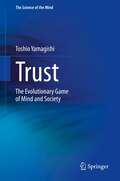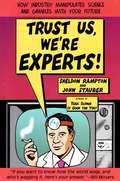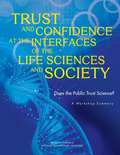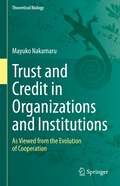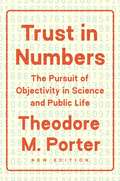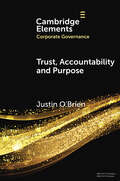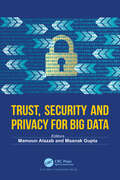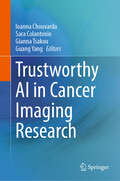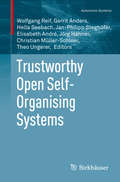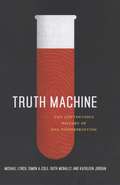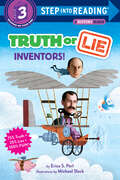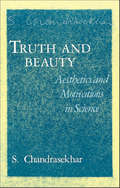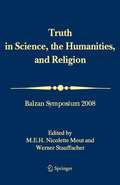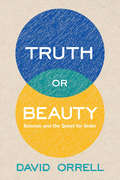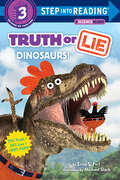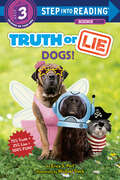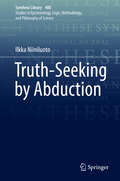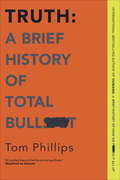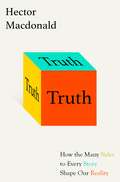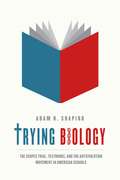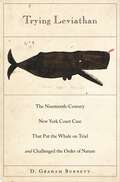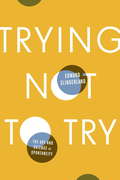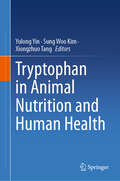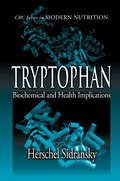- Table View
- List View
Trust
by Toshio YamagishiThis book is written around the central message that collectivist societies produce security, but destroy trust. In collectivist societies, people are connected through networks of strong personal ties where the behavior of all agents is constantly monitored and controlled. As a result, individuals in collectivist networks are assured that others will abide by social norms, and gain a sense of security erroneously thought of as "trust." However, this book argues that this security is not truly trust, based on beliefs regarding the integrity of others, but assurance, based on the system of mutual control within the network. In collectivist societies, security is assured insofar as people stay within the network, but people do not trust in the benevolence of human nature. On the one hand, transaction costs are reduced within collectivist networks, as once accepted into a network the risk of being maltreated is minimized. However, joining the network requires individuals to pay opportunity cost, that is, they pay a cost by forgoing potentially superior opportunities outside the security of the network. In this era of globalization, people from traditionally collectivistic societies face the challenge of learning how to free themselves from the security of such collectivistic networks in order to explore the opportunities open to them elsewhere. This book presents research investigating how the minds of individuals are shaped by the conflict between maintaining security inside closed networks of strong ties, and venturing outside of the network to seek out new opportunities.
Trust Us, We're Experts
by Sheldon Rampton John StauberFearless investigative journalists Sheldon Rampton and John Stauber ( Toxic Sludge Is Good for You! and Mad Cow U.S.A.) are back with a gripping expos of the public relations industry and the scientists who back their business-funded, anti-consumer-safety agendas. There are two kinds of "experts" in question--the PR spin doctors behind the scenes and the "independent" experts paraded before the public, scientists who have been hand-selected, cultivated, and paid handsomely to promote the views of corporations involved in controversial actions. Lively writing on controversial topics such as dioxin, bovine growth hormone, and genetically modified food makes this a real page-turner, shocking in its portrayal of the real and potential dangers in each of these technological innovations and of the "media pseudo-environment" created to obfuscate the risks. By financing and publicizing views that support the goals of corporate sponsors, PR campaigns have, over the course of the century, managed to suppress the dangers of lead poisoning for decades, silence the scientist who discovered that rats fed on genetically modified corn had significant organ abnormalities, squelch television and newspaper stories about the risks of bovine growth hormone, and place enough confusion and doubt in the public's mind about global warming to suppress any mobilization for action. Rampton and Stauber introduce the movers and shakers of the PR industry, from the "risk communicators" (whose job is to downplay all risks) and "outrage managers" (with their four strategies--deflect, defer, dismiss, or defeat) to those who specialize in "public policy intelligence" (spying on opponents). Evidently, these elaborate PR campaigns are created for our own good. According to public relations philosophers, the public reacts emotionally to topics related to health and safety and is incapable of holding rational discourse. Needless to say, Rampton and Stauber find these views rather antidemocratic and intend to pull back the curtain to reveal the real wizard in Oz. This is one wake-up call that's hard to resist.
Trust and Confidence at the Interfaces of the Life Sciences and Society: Does the Public Trust Science? A Workshop Summary
by Helaine E. ResnickDoes the public trust science? Scientists? Scientific organizations? What roles do trust and the lack of trust play in public debates about how science can be used to address such societal concerns as childhood vaccination, cancer screening, and a warming planet? What could happen if social trust in science or scientists faded? These types of questions led the Roundtable on Public Interfaces of the Life Sciences of the National Academies of Sciences, Engineering, and Medicine to convene a 2-day workshop on May 5-6, 2015 on public trust in science. This report explores empirical evidence on public opinion and attitudes toward life sciences as they relate to societal issues, whether and how contentious debate about select life science topics mediates trust, and the roles that scientists, business, media, community groups, and other stakeholders play in creating and maintaining public confidence in life sciences. Does the Public Trust Science? Trust and Confidence at the Interfaces of the Life Sciences and Society highlights research on the elements of trust and how to build, mend, or maintain trust; and examine best practices in the context of scientist engagement with lay audiences around social issues.
Trust and Credit in Organizations and Institutions: As Viewed from the Evolution of Cooperation (Theoretical Biology)
by Mayuko NakamaruThis book shows that evolutionary game theory can unravel how mutual cooperation, trust, and credit in a group emerge in organizations and institutions. Some organizations and institutions, such as insurance unions, credit unions, and banks, originated from very simple mutual-aid groups. Members in these early-stage mutual-aid groups help each other, making rules to promote cooperation, and suppressing free riders. Then, they come to “trust” not only each other but also the group they belong to, itself. The division of labor occurs when the society comes to have diversity and complexity in a larger group, and the division of labor also requires mutual cooperation and trust among different social roles. In a larger group, people cannot directly interact with each other, and the reputation of unknown people helps other decide who is a trustworthy person. However, if gossip spreads untruths about a reputation, trust and cooperation are destroyed. Therefore, how to suppress untrue gossip is also important for trust and cooperation in a larger group. If trustworthiness and credibility can be established, these groups are successfully sustainable. Some develop and evolve and then mature into larger organizations and institutions. Finally, these organizations and institutions become what they are now. Therefore, not only cooperation but also trust and credit are keys to understanding these organizations and institutions.The evolution of cooperation, a topic of research in evolutionary ecology and evolutionary game theory, can be applied to understanding how to make institutions and organizations sustainable, trustworthy, and credible. It provides us with the idea that evolutionary game theory is a good mathematical tool to analyze trust and credit. This kind of research can be applied to current hot topics such as microfinance and the sustainable use of ecosystems.
Trust in Numbers: The Pursuit of Objectivity in Science and Public Life
by Theodore M. PorterA foundational work on historical and social studies of quantificationWhat accounts for the prestige of quantitative methods? The usual answer is that quantification is desirable in social investigation as a result of its successes in science. Trust in Numbers questions whether such success in the study of stars, molecules, or cells should be an attractive model for research on human societies, and examines why the natural sciences are highly quantitative in the first place. Theodore Porter argues that a better understanding of the attractions of quantification in business, government, and social research brings a fresh perspective to its role in psychology, physics, and medicine. Quantitative rigor is not inherent in science but arises from political and social pressures, and objectivity derives its impetus from cultural contexts. In a new preface, the author sheds light on the current infatuation with quantitative methods, particularly at the intersection of science and bureaucracy.
Trust, Accountability and Purpose: The Regulation of Corporate Governance (Elements in Corporate Governance)
by Justin O'BrienThe collapse of trust can be found across all of our institutions but most of all in finance. This Element seeks to answer an existential question: how to rebuild trust in distrusting times? Integrity, responsibility and accountability must be embedded into corporate mission statements, values and codes of conduct. Through organisational and regulatory design across five interlocking themes - legal, regulatory, managerial, ethical and social. What is required is substantive rather than technical compliance; warranted rather than stated commitment to high ethical standards; effective deterrence strategies; enhanced accountability; and a shared commitment to risk within negotiated, binding and enforceable parameters.
Trust, Security and Privacy for Big Data
by Mamoun AlazabData has revolutionized the digital ecosystem. Readily available large datasets foster AI and machine learning automated solutions. The data generated from diverse and varied sources including IoT, social platforms, healthcare, system logs, bio-informatics, etc. contribute to and define the ethos of Big Data which is volume, velocity and variety. Data lakes formed by the amalgamation of data from these sources requires powerful, scalable and resilient storage and processing platforms to reveal the true value hidden inside this data mine. Data formats and its collection from various sources not only introduce unprecedented challenges to different domains including IoT, manufacturing, smart cars, power grids etc., but also highlight the security and privacy issues in this age of big data. Security and privacy in big data is facing many challenges, such as generative adversary networks, efficient encryption and decryption algorithms, encrypted information retrieval, attribute-based encryption, attacks on availability, and reliability. Providing security and privacy for big data storage, transmission, and processing have been attracting much attention in all big data related areas.The book provides timely and comprehensive information for researchers and industry partners in communications and networking domains to review the latest results in security and privacy related work of Big Data. It will serve computer science and cybersecurity communities including researchers, academicians, students, and practitioners who have interest in big data trust privacy and security aspects. It is a comprehensive work on the most recent developments in security of datasets from varied sources including IoT, cyber physical domains, big data architectures, studies for trustworthy computing, and approaches for distributed systems and big data security solutions etc.
Trustworthy AI in Cancer Imaging Research
by Ioanna Chouvarda Guang Yang Sara Colantonio Gianna TsakouThe book covers multiple aspects and challenges, from legal to technical and validation, in the emerging topic of AI in cancer imaging, bringing together the experience of top researchers and flagship projects. The aim of this book is to address the important questions: &“How to design AI that is trustworthy&”, and &“How to validate AI trustworthiness&” in the scope of AI for cancer imaging research. The book discusses overall considerations and the generation of a framework; preparing for trustworthy AI, including the data and metadata for quality, transparency and traceability; implementing trustworthy AI with algorithms and Decision Support Systems; and validating trustworthy AI. This is an ideal resource for researchers from technical and clinical research sites, postgraduate students, and healthcare professionals in cancer imaging and beyond.
Trustworthy Open Self-Organising Systems
by Wolfgang Reif Gerrit Anders Hella Seebach Jan-Philipp Steghöfer Elisabeth André Jörg Hähner Christian Müller-Schloer Theo UngererThis booktreats the computational use of social concepts as the focal point for therealisation of a novel class of socio-technical systems, comprising smartgrids, public display environments, and grid computing. Thesesystems are composed of technical and human constituents that interact witheach other in an open environment. Heterogeneity, large scale, and uncertaintyin the behaviour of the constituents and the environment are the rule ratherthan the exception. Ensuringthe trustworthiness of such systems allows their technical constituents tointeract with each other in a reliable, secure, and predictable way while theirhuman users are able to understand and control them. "TrustworthyOpen Self-Organising Systems" contains a wealth of knowledge, fromtrustworthy self-organisation mechanisms, to trust models, methods to measure auser's trust in a system, a discussion of social concepts beyond trust, andinsights into the impact open self-organising systems will have on society.
Truth Machine: The Contentious History of DNA Fingerprinting
by Michael Lynch Simon A. Cole Kathleen Jordan Ruth McnallyDNA profiling--commonly known as DNA fingerprinting--is often heralded as unassailable criminal evidence, a veritable "truth machine" that can overturn convictions based on eyewitness testimony, confessions, and other forms of forensic evidence. But DNA evidence is far from infallible. It is subject to the same possibilities for error--in sample collection, forensic analysis, and clerical record keeping--as any other aspect of criminal justice practice. Truth Machine traces the controversial history of DNA fingerprinting by looking at court cases in the United States and United Kingdom beginning in the mid-1980s, when the practice was invented, and continuing until the present. Using interviews, observations of courtroom trials and laboratory processes, and documentary reconstruction, the authors provide a nuanced, theoretically sophisticated, and original ethnographic account of DNA fingerprinting and its evolution. Ultimately, Truth Machine presents compelling evidence of the obstacles and opportunities at the intersection of science, technology, sociology, and law.
Truth Or Lie: Inventors! (Step into Reading)
by Erica S. PerlBudding inventors and science fair nerds will love hunting down the TRUTH about some groundbreaking inventions--past and present--and the people behind them in this innovative early reader.The computer mouse was invented by Steve Jobs, right? That's a LIE! The TRUTH is, it was invented by a man you've probably never heard of named Doug Englebart!! Though this engaging early reader is 100% fun, 25% of it is FALSE! In a unique Q&A format, proficient readers are quizzed about inventions and their inventors to see if they can separate facts from "lies." The book's mascot--the Truth Sleuth--guides readers through this funny and fact-packed book, which features photos and illustrations of a wide variety of inventions--from the printing press to velcro to a light-up soccer ball. With funny, kid-appealing art by Michael Slack.Step 3 Readers feature easy-to-follow plots about popular topics, for children who are ready to read on their own.
Truth and Beauty: Aesthetics and Motivations in Science
by S. Chandrasekhar"What a splendid book! Reading it is a joy, and for me, at least, continuing reading it became compulsive. . . . Chandrasekhar is a distinguished astrophysicist and every one of the lectures bears the hallmark of all his work: precision, thoroughness, lucidity. "—Sir Hermann Bondi, Nature The late S. Chandrasekhar was best known for his discovery of the upper limit to the mass of a white dwarf star, for which he received the Nobel Prize in Physics in 1983. He was the author of many books, including The Mathematical Theory of Black Holes and, most recently, Newton's Principia for the Common Reader.
Truth and Beauty: Aesthetics and Motivations in Science
by S. ChandrasekharSeven lectures detailing the author&’s thoughts on motivations in the pursuit of science and patterns of scientific creativity.&“What a splendid book! Reading it is a joy, and for me, at least, continuing reading it became compulsive…. Chandrasekhar is a distinguished astrophysicist and every one of the lectures bears the hallmark of all his work: precision, thoroughness, lucidity.&” —Sir Hermann Bondi, Nature Does aesthetics play a role in science? Can it be that science is given impetus by a search for beauty? What relation exists between the beauty of an idea and its power to account for some aspect of the natural world? Throughout his distinguished career, S. Chandrasekhar has given time and thought to these questions and to their implications for his work and the work of others. Truth and Beauty gathers the fruits of his meditations. Heisenberg, observes Chandrasekhar, spoke eloquently of the sheer force of his aesthetic experience when he discovered the key to the quantum theory. Weyl characterized the process of working out his gauge theory as a choice of the beautiful over the true, a choice strongly supported by subsequent research. Einstein also felt the aesthetic power underlying his discoveries. While most of the seven essays in Truth and Beauty deal generally with the nature of science and the process of research, two essays explore the work of individuals. —Edward Arthur Milne and Arthur Stanley Eddington The late S. Chandrasekhar was best known for his discovery of the upper limit to the mass of a white dwarf star, for which he received the Nobel Prize in Physics in 1983. He was the author of many books, including The Mathematical Theory of Black Holes and, most recently, Newton's Principia for the Common Reader.
Truth in Science, the Humanities and Religion
by International Balzan FoundationThe question of the meaning of "truth" is central to many areas of contemporary debate, whether between those subscribing to a post-Enlightenment view of the world and those who seek fundamental truth in religious texts, or between those maintaining that there are absolute truths and those believing facts to be social constructs. For some, the ultimate truth is revealed through religious faith and textual authority. Can this view be reconciled with an evidence-based, materialist, post-Enlightenment perspective of the truth as embraced by the natural sciences? If religion holds the key to the truth, which religion and which truths? What is the attitude of the humanities to the meaning of truth? Truth in the sciences and the humanities as well as in religion and theology is the central theme of this book based on the proceedings of a conference organized by the International Balzan Foundation. It contains the speakers' lectures, the corresponding reactions of the invited panel members as well as the general discussions. The reader can familiarize himself with views ranging from philosophy to religion, from mathematics, physics and cosmology to biological sciences, history, sociology and economics. The exceptional wide scope of the book, comprising arguments about truth in the sciences, the humanities as well as religion and theology together with the discussions between representatives of all these different fields, means that it is of interest to a professional as well as a general readership.
Truth or Beauty
by David OrrellFor millennia, scientists and philosophers have strived to show that the universe is governed by a few simple principles. These principles are not derived from science. They do not come from looking through telescopes or carefully examining the results generated by particle colliders. Rather,they are based on aesthetic laws and concepts such as symmetry, beauty, and unity. Scientist and author David Orrell considers how aesthetics have influenced the models we create in hopes of explaining our universe. His book begins with a look at early scientific thinkers, from the ancient Greeks to Galileo. The ancients constructed a concept of the world based on musical harmony;later thinkers overturned this concept, but replaced it with a program, based on Newton's "rational mechanics," to reduce the universe to a few simple equations. Orrell then turns to the scientific program of the twentieth century, culminating in supersymmetric string theory, which was againinfluenced by deep aesthetic principles. In a final section of the book, Orrell broadens his discussion to other fields of research, including economics, architecture, and health. Recent history has shown us what happens when financiers rely on a model of economics that resembles what a good theory"should look like" rather than the messy reality of human interaction. Ideas of mathematical elegance have inspired, entranced, and "sometimes misled" thinkers in their desire to find the laws that govern our universe. Orrell evaluates these aesthetic principles as a means of understanding the structure of the universe - let alone messy human society - and questionswhether they reflect an accurate way to understand our world. Truth or Beauty comes at an interesting period, when the multi-billion-dollar Large Hadron Collider in Switzerland has been designed to test the existence of exotic phenomena such as supersymmetric particles. Will these too turn out to be nothing more than a beautiful illusion?
Truth or Lie: Dinosaurs! (Step into Reading)
by Erica S. PerlDinosaur fanatics will love hunting down the TRUTH about their favorite prehistoric reptiles in this innovative new Science Reader series.Tyrannosaurus rex's closest living relative is the alligator, right? That's a LIE! The TRUTH is, the massive carnivore was actually more closely related to chickens!! Though this engaging early reader is 100% fun, 25% of it is FALSE! In a unique question-and-answer format, proficient readers are quizzed about dinosaurs to see if they can separate facts from "lies." The book's mascot--the Truth Sleuth--guides readers through this funny and fact-packed Step 3 Reader, which features photos and illustrations of dinosaurs and fossils, with funny, kid-appealing art by Michael Slack.Step 3 Readers feature engaging characters in easy-to-follow plots about popular topics, for children who are ready to read on their own.
Truth or Lie: Dogs! (Step into Reading)
by Erica S. PerlYoung dog lovers will enjoy sniffing out the TRUTH about their favorite animals in this innovative Step 3 nonfiction reader.Dogs don't sniff each other's butts as often as we think, right? That's a LIE! The TRUTH is, dogs almost always greet each this way! It gives them lots of information about other dogs. Though this engaging early reader is 100% fun, 25% of it is FALSE! In a unique Q&A format, proficient readers are quizzed about dogs to see if they can separate facts from "lies." The book's mascot--the Truth Sleuth--guides readers through this funny and fact-packed book, which features photos and illustrations of a wide variety of canines.Step 3 Readers feature easy-to-follow plots about popular topics, for children who are ready to read on their own.
Truth-Seeking by Abduction (Synthese Library #400)
by Ilkka NiiniluotoThis book examines the philosophical conception of abductive reasoning as developed by Charles S. Peirce, the founder of American pragmatism. It explores the historical and systematic connections of Peirce's original ideas and debates about their interpretations. Abduction is understood in a broad sense which covers the discovery and pursuit of hypotheses and inference to the best explanation. The analysis presents fresh insights into this notion of reasoning, which derives from effects to causes or from surprising observations to explanatory theories.The author outlines some logical and AI approaches to abduction as well as studies various kinds of inverse problems in astronomy, physics, medicine, biology, and human sciences to provide examples of retroductions and abductions. The discussion covers also everyday examples with the implication of this notion in detective stories, one of Peirce’s own favorite themes.The author uses Bayesian probabilities to argue that explanatory abduction is a method of confirmation. He uses his own account of truth approximation to reformulate abduction as inference which leads to the truthlikeness of its conclusion. This allows a powerful abductive defense of scientific realism. This up-to-date survey and defense of the Peircean view of abduction may very well help researchers, students, and philosophers better understand the logic of truth-seeking.
Truth: A Brief History Of Total Bullsh*t
by Tom Phillips“A lighthearted history of lying”—from the international bestselling author of Humans: A Brief History of How We F*cked It All Up (Kirkus Reviews).We live in a “post-truth” world, we’re told. But was there ever really a golden age of truth-telling? Or have people been lying, fibbing and just plain bullsh*tting since the beginning of time?Tom Phillips, editor of a leading independent fact-checking organization, deals with this question every day. In Truth, he tells the story of how we humans have spent history lying to each other—and ourselves—about everything from business to politics to plain old geography. Along the way, he chronicles the world’s oldest customer service complaint, the Great Moon Hoax of 1835 and the surprisingly dishonest career of Benjamin Franklin.Sharp, witty and with a clear-eyed view of humanity’s checkered past, Truth reveals why people lie—and how we can cut through the bullsh*t.Praise for Humans: A Brief History of How We F*cked It All Up“A laugh-along, worst-hits album for humanity.” —Steve Brusatte, New York Times–bestselling author of The Rise and Reign of the Mammals“[A] perfect blend of brilliance and goofiness.” —BuzzFeed“[A] timely, irreverent gallop through thousands of years of human stupidity.” —Nicholas Griffin, author of The Year of Dangerous Days“Chronicles humanity’s myriad follies down the ages with malicious glee and much wit . . . a rib-tickling page-turner.” —Business Standard
Truth: How the Many Sides to Every Story Shape Our Reality
by Hector MacDonaldFrom one of the world's leading experts in business storytelling, and for readers of Daniel Levitin, Nate Silver, and Charles Duhigg, Truth: A User's Guide is about the different types of competing truths we face every day in life: how to identify them, why they work, when they are used and misused, and what we can do to guard against them or--when appropriate--to make constructive use of them.We tend to see the world like Orwell's Winston Smith: "There was truth and there was untruth." Yet the world is far more complicated than that. In a time of "post-truth", when "fake news" is itself the subject of our headlines, it is not "untruths" that we need to worry about. Hector Macdonald reveals and examines one of our greatest collective blind spots: we are all routinely misled by the truth. This is because for any fact, scenario, story, and situation, there are what Hector terms "Competing Truths." Why do Competing Truths matter? They matter because we vote, shop, work, co-operate, and fight based on what we believe to be true, and what we believe depends in large part on what we read or hear from others. Many of the most sophisticated and influential forms of political, business, and media communication manipulate technically true statements to pull the wool over the public's eyes. Truth is not an absolute--it has its own spectrum. Truth: A User's Guide shows us how to cut through the nebulous issue of truth using a scaffold of timely examples. These examples range from the disingenuous use of statistics in Donald Trump's speeches to the 2013 fallacy that Western quinoa demand was disadvantaging native Andean farmers, to the structure, ethics, and success of Uber. Macdonald is as comfortable and insightful parsing the influence of Facebook as he is examining Colgate's misleading campaign as the toothpaste recommended by dentists. Truth: A User's Guide explores how we can guard against the noise of competing truths, in business, in our personal relationships, and within ourselves, but also how we can use them to our advantage. Written with authority and humour, this is an accessible and illuminating narrative that will find a wide audience among readers in search of understanding why the meaning of "truth" seems to have gone completely haywire.
Trying Biology: The Scopes Trial, Textbooks, and the Antievolution Movement in American Schools
by Adam R. ShapiroIn Trying Biology, Adam R. Shapiro convincingly dispels many conventional assumptions about the 1925 Scopes "monkey" trial. Most view it as an event driven primarily by a conflict between science and religion. Countering this, Shapiro shows the importance of timing: the Scopes trial occurred at a crucial moment in the history of biology textbook publishing, education reform in Tennessee, and progressive school reform across the country. He places the trial in this broad context--alongside American Protestant antievolution sentiment--and in doing so sheds new light on the trial and the historical relationship of science and religion in America. For the first time we see how religious objections to evolution became a prevailing concern to the American textbook industry even before the Scopes trial began. Shapiro explores both the development of biology textbooks leading up to the trial and the ways in which the textbook industry created new books and presented them as "responses" to the trial. Today, the controversy continues over textbook warning labels, making Shapiro's study--particularly as it plays out in one of America's most famous trials--an original contribution to a timely discussion.
Trying Leviathan: The Nineteenth-Century New York Court Case That Put the Whale on Trial and Challenged the Order of Nature
by D. Graham BurnettIn Moby-Dick, Ishmael declares, "Be it known that, waiving all argument, I take the good old fashioned ground that a whale is a fish, and call upon holy Jonah to back me." Few readers today know just how much argument Ishmael is waiving aside. In fact, Melville's antihero here takes sides in one of the great controversies of the early nineteenth century--one that ultimately had to be resolved in the courts of New York City. In Trying Leviathan, D. Graham Burnett recovers the strange story of Maurice v. Judd, an 1818 trial that pitted the new sciences of taxonomy against the then-popular--and biblically sanctioned--view that the whale was a fish. The immediate dispute was mundane: whether whale oil was fish oil and therefore subject to state inspection. But the trial fueled a sensational public debate in which nothing less than the order of nature--and how we know it--was at stake. Burnett vividly recreates the trial, during which a parade of experts--pea-coated whalemen, pompous philosophers, Jacobin lawyers--took the witness stand, brandishing books, drawings, and anatomical reports, and telling tall tales from whaling voyages. Falling in the middle of the century between Linnaeus and Darwin, the trial dramatized a revolutionary period that saw radical transformations in the understanding of the natural world. Out went comfortable biblical categories, and in came new sorting methods based on the minutiae of interior anatomy--and louche details about the sexual behaviors of God's creatures. When leviathan breached in New York in 1818, this strange beast churned both the natural and social orders--and not everyone would survive.
Trying Not to Try: Ancient China, Modern Science, and the Power of Spontaneity
by Edward SlingerlandA deeply original exploration of the power of spontaneity--an ancient Chinese ideal that cognitive scientists are only now beginning to understand--and why it is so essential to our well-being Why is it always hard to fall asleep the night before an important meeting? Or be charming and relaxed on a first date? What is it about a politician who seems wooden or a comedian whose jokes fall flat or an athlete who chokes? In all of these cases, striving seems to backfire. In Trying Not To Try, Edward Slingerland explains why we find spontaneity so elusive, and shows how early Chinese thought points the way to happier, more authentic lives. We've long been told that the way to achieve our goals is through careful reasoning and conscious effort. But recent research suggests that many aspects of a satisfying life, like happiness and spontaneity, are best pursued indirectly. The early Chinese philosophers knew this, and they wrote extensively about an effortless way of being in the world, which they called wu-wei (ooo-way). They believed it was the source of all success in life, and they developed various strategies for getting it and hanging on to it. With clarity and wit, Slingerland introduces us to these thinkers and the marvelous characters in their texts, from the butcher whose blade glides effortlessly through an ox to the wood carver who sees his sculpture simply emerge from a solid block. Slingerland uncovers a direct line from wu-wei to the Force in Star Wars, explains why wu-wei is more powerful than flow, and tells us what it all means for getting a date. He also shows how new research reveals what's happening in the brain when we're in a state of wu-wei--why it makes us happy and effective and trustworthy, and how it might have even made civilization possible. Through stories of mythical creatures and drunken cart riders, jazz musicians and Japanese motorcycle gangs, Slingerland effortlessly blends Eastern thought and cutting-edge science to show us how we can live more fulfilling lives. Trying Not To Try is mind-expanding and deeply pleasurable, the perfect antidote to our striving modern culture.From the Hardcover edition.
Tryptophan in Animal Nutrition and Human Health
by Yulong Yin Sung Woo Kim Xiongzhuo TangThis book integrates the research progress of Tryptophan (Trp) and its metabolites in animal nutrition and human health. It recapitulates the effects of Trp nutrition on the regulation of various physiological functions in farmed animals as well as the clinical connections between Trp metabolism and human diseases. Furthermore, this book includes detailed information about the manufacturing process of industrial Trp production and methodologies to study Trp metabolism. This book not only brings numerous benefits to academic communities worldwide but also provides practical values for industrial professionals/companies. Both of these two aspects will expand our understanding of how amino acid metabolism contributes to the maintenance of host health.
Tryptophan: Biochemical and Health Implications (Modern Nutrition)
by Herschel SidranskyHistorically, the amino acid tryptophan has been considered to play a role in cancer development and the aging process. In recent times, this nutrient has been associated with eosinophila myalgia syndrome - a new human disease that attacks the muscular system. This detailed book examines the implications of the large measure of fresh information ga
